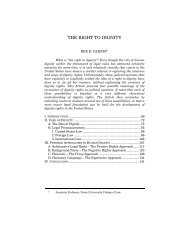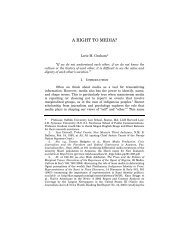CHAPTER 33 - Columbia Law School
CHAPTER 33 - Columbia Law School
CHAPTER 33 - Columbia Law School
You also want an ePaper? Increase the reach of your titles
YUMPU automatically turns print PDFs into web optimized ePapers that Google loves.
Ch. <strong>33</strong> TEMPORARY RELEASE PROGRAMS 909<br />
follow the required procedures. However, the Supreme Court’s decision in Sandin v. Conner makes it<br />
much more difficult for you to prove that your removal from the program has caused you harm that<br />
is “atypical” of what you should expect as a prisoner. 98 Temporary release programs and work<br />
release programs have not always been found to be interests protected by the Constitution for New<br />
York state prisoners. 99<br />
Unfortunately, the regulations governing temporary release leave much discretion to the facility<br />
temporary release administrators. They will be able to make many decisions as they see fit, as long<br />
as they are fair and impartial. You will only be entitled to the minimum due process requirements if<br />
your temporary release is denied. The Dutchess County Supreme Court stated in Roman v. Ternullo<br />
that correctional facility superintendents were required to extend procedural due process safeguards<br />
outlined by the United States Supreme Court in Wolff v. McDonnell. 100 These requirements include a<br />
hearing presided over by an impartial observer, notice of the hearing, help in preparing a defense,<br />
and a copy of the decision made at the hearing. You may be able to call witnesses, but you will not<br />
be able to cross-examine adverse witnesses. 101 However, you must be able to prove that the wrong<br />
conclusion was reached in your TRC hearing, and that the procedure was incorrect. 102<br />
If you feel that your rights have been violated in a revocation of temporary release, you can file a<br />
lawsuit. However, you must base your complaint on a particular statute or law that will give a judge<br />
power to hear how the prison authorities have treated you. There are several different ways that you<br />
can do this.<br />
The two ways to get a judge to hear your complaint about the revocation of your temporary<br />
release are by using one of these statutes: (1) Article 78 of the New York Civil Practice <strong>Law</strong> and<br />
Rules (called Article 78 of the C.P.L.R.) in New York courts, or (2) 42 U.S.C. § 1983 (called Section<br />
1983) in state or federal court.<br />
98. Sandin v. Conner, 515 U.S. 472, 486–87, 115 S. Ct. 2293, 2301–02, 132 L. Ed. 2d 418, 419 (1995) (holding that a<br />
prisoner is not deprived of a liberty interest when he is removed from a temporary release program because he was placed<br />
in segregated confinement because discipline by prison officials in response to misconduct falls within expected boundaries<br />
of the prisoner’s sentence).<br />
99. See Greaves v. New York, 951 F. Supp. <strong>33</strong>, 36 (S.D.N.Y. 1996) (prisoner removed from work release program<br />
had constitutional liberty interest, even after Sandin); Roucchio v. Coughlin, 923 F. Supp. 360, 370, 377 (E.D.N.Y. 1996)<br />
(finding no federal constitutional interest in removal from work release program, but finding that New York may have<br />
created a right to an individualized due process hearing when it created the Temporary Release Program). However, these<br />
cases may not be good law as other cases have found no liberty interests of any kind, and the Roucchio case itself was later<br />
dismissed. See Roucchio v. Coughlin, 29 F. Supp. 2d 72, 83 (E.D.N.Y. 1998); see also Romer v. Morgenthau, 119 F. Supp.<br />
2d 346, 359 (D.N.Y. 2000) (holding that the denial of a prisoner’s application for work release participation did not violate<br />
a protected liberty interest); Dudley v. Coombe, No. 96 Civ. 1665 (MGC), 1997 U.S. Dist. LEXIS 10883, at *6 (S.D.N.Y.<br />
July 28, 1997) (unpublished) (holding that dismissal from work release program is not “atypical of prison life” and,<br />
therefore, is acceptable). But see Friedl v. City of N.Y., 210 F.3d 79, 85 (2d Cir. 2000) (holding that due process protections<br />
apply to work release participation revocation).<br />
100. Roman v. Ternullo, 81 Misc. 2d 1023, 1025, 367 N.Y.S.2d 197, 198 (Sup. Ct. Dutchess County 1975); Wolff v.<br />
McDonnell, 418 U.S. 539, 563–66, 94 S. Ct. 2963, 2978–80, 41 L. Ed. 2d 935, 936 (1974); see also Marciano v. Goord,<br />
2006 N.Y. Misc. LEXIS 2656, at *17–19 (N.Y. Misc. 2006) (citing Wolff in discussion of due process requirements for<br />
removal of a prisoner from a temporary release program, including requirements of prior hearing, notice, and opportunity<br />
to be heard); MacCowan v. Cummings, 99 Misc. 2d 914, 916–917 (N.Y. Misc. 1978) (holding that “any removal [of the<br />
prisoner] from the [work release] program should be as a result of a hearing following the rationale and procedures set forth<br />
in Wolff v McDonnell”). See JLM Chapter 35, “Parole,” for a more detailed explanation of the due process rights guaranteed<br />
under Wolff. The Supreme Court has also held that due process requires certain procedural protections for prisoners<br />
participating in a state-created pre-parole conditional supervision program. See Young v. Harper, 520 U.S. 143, 146–47,<br />
117 S. Ct. 1148, 1151, 137 L. Ed. 2d 270, 271 (1997).<br />
101. See Morales v. Ward, 89 Misc. 2d 651, 653, 392 N.Y.S.2d 197, 199 (Sup. Ct. Albany County 1977) (stating that<br />
prisoners are not entitled to the same degree of procedural due process as parolees for revocation of their privileges).<br />
102. See Roucchio v. Coughlin, 29 F. Supp. 2d 72, 79–80 (E.D.N.Y. 1998).















